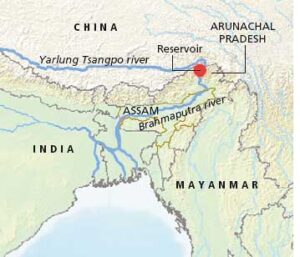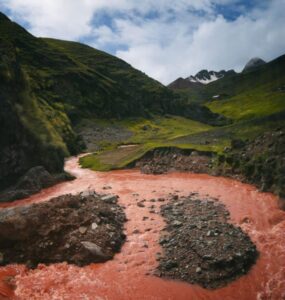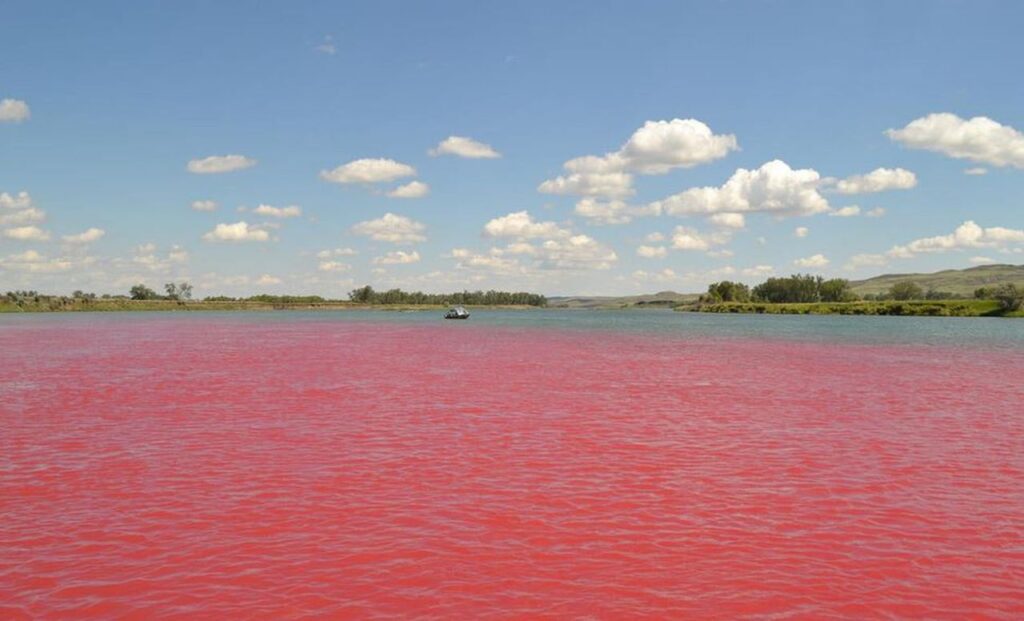Red River of India
-by Abhrajita Mondal
–Reading Time – 6 min Approx
–Edited by – Srishti Bhattacharyya
Whenever the topic of the red river of India comes up, know at once that they are talking about the Brahmaputra River, also known as the Tsangpo-Brahmaputra. Initially, it was a ‘Kund’, i.e., a tank or reservoir for collecting rainwater. Currently a transboundary river, it flows through Tibet, India, and Bangladesh. This river originating from the Mansarovar Lake region is amongst the list of largest and longest rivers in India. The name Brahmaputra means ‘the son of Brahma’. The Hindu God of Creation Brahma, sired in the river, which later came to be known as the Brahmaputra. 
The river rises in Tibet and passes through India and Bangladesh. It is called Tsangpo in Tibet, Brahmaputra or Lohit in India, and Jamuna in Bangladesh. The water in the river has a red tinge, hence the name ‘red river of India’.
The word ‘Lohit’ comes from ‘Lahu’ which means ‘blood’ in Urdu. The story goes that a Brahmin called cc, after killing his mother with an axe had gotten the axe stuck to his hand. He then came to the river to wash his hands and get rid of the axe. It is said that when he submerged his hands in the water, the water turned red. He then flung the axe away, thus carving a path for the river. The red color of the river is due to the blood.
Why is the Red River of India Important?
The Red River of India is the lifeline of the people who live in Assam. Most of the people living in Assam use the water of Brahmaputra for agriculture, fishing, and wading of cattle. There are at least ten ferry ghats that are directly reliant on the Brahmaputra River for transportation. Moreover, there are nineteen important tourist spots around the river, leading to the opening of various jobs. Cruise tourism is also on the rise. CNN has recognized Brahmaputra Cruises as one of the top cruises in India. The river and its tributaries are the main sources of water in the state.
The location of the river makes it important for both India and China. The river is important for China as it considers Tibet to be a part of its territory. It also has vested interests in Arunachal Pradesh. The river discharges about 19,300 cubic meters per second, thus producing hydroelectricity that is vital for the developing nations around it. It is also helpful in the transportation of heavy materials.
The Blue River of India:
The Lukha River in Meghalaya is the blue river of India. Meghalaya is, without a doubt, one of the most beautiful destinations in India. There is no dearth of scenic locales and natural resources in the state. The Lukha River is located in the southern part of the East Jaintia Hills of Meghalaya. It receives water from the Lunar River. On its way, the river passes through Sonapur Village and Surma Valley before eventually flowing into Bangladesh.
However, the overall quality of the river is known to be poor. The limestone mining and manufacturing of cement in the nearby areas have led to the deterioration of the river. The color changes into a vibrant blue during the winter months. The water remains deep blue in December, January, and February before the rainwater dilutes the water and leads to a change in color.
The Lukha River is filled with fish. Moreover, it is often called ‘Wah Lukha’, meaning a ‘reservoir of fish’. Apart from sustaining the livelihood for people around the area, it is also popular for boating races.
The Red River Peru:
Like India, Peru also has a Red River located in Cusco. The red river Peru is a work of art by none other than Mother Earth. The river in Cusco is red due to the presence of iron oxide. The river looks red in the monsoon season while during the rest of the year it remains muddy brown.
The Red River lays in the Canchis Province of the Cusco region, about a few hours southeast of the city of Cusco, Peru. It originates from Palcoyo Rainbow Mountain Valley. Most tourists on their visit to Peru prefer not to miss seeing this river. To enjoy the colors of the river the best time to visit is between May and November when the water is high. Peru has no dearth of scenic locales. It has some of the most scenic areas in the entire world. However, the red river Peru seems to steal the show. The locals call it Palquella Pucamayu.
The red section runs for about 5 km after which it mixes with other streams and the color loses its vibrancy. The smaller tributaries eventually flow into the Machu Pichu region. The river is known as the Urubamba River further downstream. In the end, it feeds into the Amazon.
Red River China:
The Hong River is also known as the Red River in China. The name Yuan River is also associated with it since it originated in the Yunnan province. It flows southeastwards and passes through Dai before entering Vietnam. Moreover, it forms a portion of the international borders between China and Vietnam. The river is also called the Thao River. The flow of the river is irregular however it is quite a sight to behold. The reddish-brown color of the river is due to the silt-laden water. The chief tributaries of the red river China are the Black River and the Lô River.
Back in the 19th century, the Red River served as a transportation route to China. It was the main commercial route.
Red Rivers of the World:
There are many such ‘red rivers’ all around the world. Spain has a red river named Rio Tinto, located in southwestern Spain. It is a stunning visual treat for the eyes. The Red River in Spain has been there for ages. Only around 50 km of the river is red near the town of Niebla. The concerned area has large amounts of sulfide deposits. Moreover, there are a few ores as well. The lethal combination of sulfides and ores gives the water the red or plum color.
The Red River of the South is in the USA. It rises in the high plains of Mexico and is almost 1,290 miles long. It is a tributary of the two rivers, Atchafalaya and Mississippi. The red-colored soil of the river basin gives this characteristic name and it is also the second-largest river basin.
The Red River of the South played a historical role in the culture of the North Americans. The river has a rich biodiversity. You will find many blue catfish and striped bass in the waters. There are many birds around the region. If you are a bird watcher, you are in for a surprise. You can find waterfowls, songbirds, and the red-headed woodpecker in the vicinity of the river. Reptiles and deer are a constant of the region. There are several lakes that the Red River feeds. They are Buffalo Lake, Baylor Lake, Lake Crook, and Electra Lake, to name a few.
So, today you learned about the various red rivers of the world. In most cases, you must have noticed that the name comes from the color of the soil which has changed due to the presence of ores, iron oxides, and sulfides. For Indians, the River Brahmaputra is a revered red river. There are other colors as well. You already know about Lukha. Next time you might get glimpses into the green and yellow rivers in India.
-by Abhrajita Mondal
Dear Reader, Hope you liked the post. If you think our initiative “The Creative Post” is worth supporting, then please support us by paying the amount you think we are worthy of. We believe, the value of content should be decided by the consumer. Hence we request you to evaluate our worth and pay accordingly by Clicking Here.


